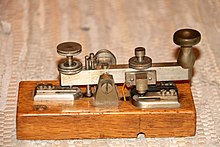
Back Telegrafní klíč Czech Morsenøgle Danish Morsetaste German Morsoklavo Esperanto Manipulador telegráfico Spanish Manipulateur morse French מפתח מורס HE Tasto telegrafico Italian 電鍵 Japanese 전건 Korean
This article needs additional citations for verification. (December 2024) |
 A straight key style of telegraph key – model J-38, a key used by U.S. military during World War II, and frequently re-used by radio amateurs | |
| Type | Switch |
|---|---|
| Electronic symbol | |
 | |


A telegraph key, clacker, tapper or morse key is a specialized electrical switch used by a trained operator to transmit text messages in Morse code in a telegraphy system.[1] Keys are used in all forms of electrical telegraph systems, including landline (also called wire) telegraphy and radio (also called wireless) telegraphy. An operator uses the telegraph key to send electrical pulses (or in the case of modern CW, unmodulated radio waves) of two different lengths: short pulses, called dots or dits, and longer pulses, called dashes or dahs. These pulses encode the letters and other characters that spell out the message.
- ^ "Telegraph Key". National Museum of American History. Smithsonian Institution. Retrieved 15 December 2024.